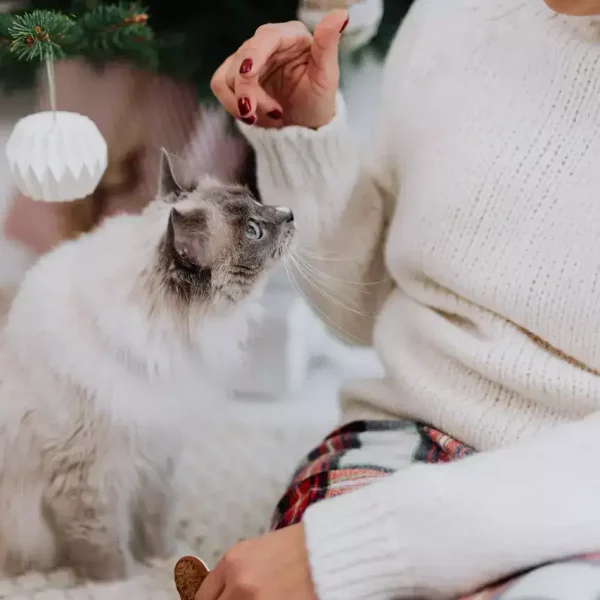It is every owner’s worst nightmare to see their cat in pain or distress. Unfortunately, our feline friends are no strangers to getting themselves into dangerous situations which require the intervention of their pet parents.
More often than not, cats will scoff their food down within moments, leaving their owners with an empty bowl to clean in less than a minute. Thankfully, in most cases, this behavior occurs without any issues.
However, from time to time, they may begin to cough or show other signs that they are struggling to swallow a portion of their food.
In this guide I give my tips on what to do when a cat is choking on food or anything else for that matter. There are also videos which show the process too you will find helpful.
What to do when a cat is choking on something
Watch this video below if you are in a hurry:
1. Keep the cat calm but still act quiclkly
The first step you should take is to move your cat into an area where you can act rapidly. At times, cats may flee from their owners in a state of panic when choking, especially if they mistake their owner’s distress and anxiety for anger.
If they are trying to escape from the room in which they are fed, quickly close the door and corner them in an area so that you can help them.
If they are in the garden, try not to frighten them by running towards them, instead approach in a brisk but calm manner.
That being said, if your cat is within arm’s reach and is actively looking for help, make sure that you prioritize helping them over blocking off any exits.
2. Hold the cat’s mouth open
From here, you will have to attempt to dislodge the item that is stuck in your cat’s throat by restraining and holding their mouth open. If you have a family member close by, ask them to assist you in this task and focus on trying to remove the object.
Bear in mind that your cat will be panicked, and as such, you should refrain from sticking your fingers completely into their mouth unless you have the strength required to keep them from accidentally biting.
3. Grab your cat’s tongue
Next, grab your cat’s tongue, ideally using a cloth or some other material to help your grip, and gently move the tongue out of the way. If the blockage is visible, slowly and carefully move your fingers from one side of the throat to the other, aiming to dislodge the item.
However, if the object is particularly large, be careful not to push it further down the throat, as this could significantly worsen the situation. Instead, grab some tongs and try and remove the object, being extra careful not to harm your cat in the process.
4. Use the Heimlich manoevre
If this does not work, or if you are unable to see the object, you will have to resort to performing the Heimlich Manoeuvre on your cat.
To begin doing this, position your cat so that it is standing on its hind legs with its back against your body – If it is a smaller cat, you can pick them up instead.
In addition, make sure that your cat’s head is facing up, and that its paws are facing towards the ground.
5. Firmly push behind the rib cage
Next, place your arms around your cat’s belly and make a fist with your hands. From here, firmly push up and forwards with your fist behind the rib cage in a thrusting action.
You will likely have to repeat this maneuver several times before the object is properly dislodged from your cat’s throat. When it comes to smaller cat’s, the process is much the same, except it is safer to use the palm of your hand instead of your fist.
6. Check for anything else still stuck
Once the food or object has been dislodged successfully, make sure that you check your cat’s mouth for the offending item and remove it carefully.
By doing this, you will prevent them from swallowing it, thus reducing the chance of it getting stuck in their throat again (which can happen more often than people realize, especially if the cat is still dazed or in a state of shock).
Place a bowl of water near your cat and comfort them if they are still showing signs of distress or anxiety.
7. Contact your vet
After this procedure, ensure that you contact your vet immediately and explain what has happened. The vet may recommend that you bring them your cat in to check for oxygen deprivation or damage to the mouth and throat caused by the blockage.
In most instances, cats will recover extremely quickly from choking, however, a degree of caution is needed to ensure that there is no long-lasting or permanent damage to their health.
Lastly, you must immediately rush to a veterinarian or pet hospital if your cat is still choking after having attempted these steps.
How to reduce the risk of your cat choking
Now you know what to do when a cat is choking, here are steps you can take to reduce the chance of it happening in the first place.
First and foremost, you must prevent your cat from inhaling its food if you want to significantly reduce the chance of choking in the future.
Across the country, thousands of cats have trouble eating their meals slowly, and as a result, this can greatly increase their risk of getting a piece of kibble or other cat food stuck in their mouth or throat.
Alongside this, fast eating habits in felines can also cause them to develop other medical issues, such as bloating, regurgitation, and in some serious cases, twisted stomachs or gastric volvulus.
To prevent your cat from eating too fast, you will need to purchase a cat bowl specifically engineered to slow down their eating and make them chew their food. These bowls are occasionally referred to as puzzle bowls and come in a variety of different shapes, designs, and sizes.
For example, many have raised wall-like areas in the middle of the bowl separating portions of the food. Other bowls feature several small compartments that divide the food up equally, making it challenging for hungry cats to scoff their food down all in one go.
Alongside this, pet parents must always research information regarding chewable treats and toys they are buying their kittens.
Unfortunately, many chewable treats on the market are extremely dangerous for cats due to their tendency to break up into small pieces that can easily get lodged in their throats.
Similarly, certain cat toys can also prove dangerous, especially if cats are left alone to chew for long periods during the day.
That being said, there are a plethora of new products available on the market that pose fewer choking risks for felines, many of which can be found in popular cat stores or online.
Generally, this phenomenon rarely results in an emergency, as most felines, within a few seconds, will dislodge whatever morsel of food is stuck in their mouth or throat without the need for assistance.
However, it is not unusual for pet parents to remain a little shaken up afterward, especially if it is the first time this has occurred. Naturally, they may start to imagine what might have happened if their beloved companion was choking for real and what they could have done if the situation had turned critical.
Identifying cat choking signs
It is important to recognize when your cat is seriously choking so that you can act accordingly and save them. As mentioned above, the first sign of choking is usually coughing, which will quickly turn into violent hacking if the affected felines is unable to dislodge whatever is stuck in its throat.
Believe it or not, cats don’t just choke on food or rawhide, then can ever choke on water.
Alongside this, your cat may have trouble inhaling and will gasp and paw at its head or mouth and begin to panic. Similarly, other signs to look out for are excessive drooling, wide eyes from extreme distress, retching, and in very critical scenarios, blue skin discoloration.
Conclusion
Sadly, the knowledge of how to save a cat when it is choking on food, bones, or a piece of its toy is not widely known amongst the feline community.
Consequently, the vast majority of cat owners would find themselves in an extremely stressful and harrowing situation if their cat began to choke.
Please do take time to read the notes above and watch the videos which show you what to do when your cat is choking.



Leave a Comment